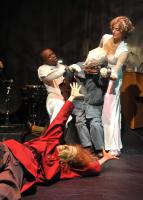 Chances are, you’re well familiar with the story – man (here, soldier) meets the devil on a dusty road; said trickster promises wealth in exchange for something important; hero accepts the ill-advised deal, suffers the unforeseen consequences, and struggles to undo his mistake. It’s a moral-teaching folk tale that spans cultures (the Russian ones are usually a little bleaker), and Igor Stravinsky’s iteration more or less sticks to the formula.
Chances are, you’re well familiar with the story – man (here, soldier) meets the devil on a dusty road; said trickster promises wealth in exchange for something important; hero accepts the ill-advised deal, suffers the unforeseen consequences, and struggles to undo his mistake. It’s a moral-teaching folk tale that spans cultures (the Russian ones are usually a little bleaker), and Igor Stravinsky’s iteration more or less sticks to the formula.
Understandably, then, the selling points for the Aurora Theatre Company‘s production of The Soldier’s Tale are pronouncedly stylistic. Foremost among them, the soldier is a human-scale puppet, operated by the recently retired principal dancer for the San Francisco Ballet, Muriel Maffre, and voiced by L. Peter Callender, who also serves as a sort of outside narrator.
Maffre fills the role of the soldier’s romantic prize as well, separating herself from the puppet to perform this female character’s solo ballet dance. Classical chamber group Earplay sets this boldly unconventional affair to Stravinsky’s distinctive score.
What unfolds, though at times beautiful (Maffre moves the soldier deftly and with a dancer’s striking grace), quickly comes to feel contrived. The attempts to capture Stravinsky’s rhythm, like Donald Pippin’s rhymed and metered English translation, wind up calling too much attention to themselves. In brief, the array of stylistic components – storytelling, acting, pupeteering, live music, dance – just don’t quite click.
At times, the result is downright awkward. For instance, while Maffre’s climactic dance is itself an impressive highlight, its insertion into the play is less than seamless. Having a single actor switch from one character (or, a part of one – the soldier’s physical animator) to another and back is a lot to ask of the audience’s imagination. It completely removed me from the story.
The puppet element is, in this way, to blame for many of the production’s awkward disjunctures. Though intellectually intriguing (a character’s body, movements, and voiced thoughts are usually conjoined in one actor, yet here they are distributed among three, one of which is an inanimate object), it strains the audience’s ability to make believe. The audience must look in three separate places instead of one to gather the facial expressions, gestures and movements that add up to an emotional, “real” character. The story-world is just that much further removed.
Experimental artistic gestures like this one are bound to induce some intellectual distancing – that’s the point. A narrative as simple as The Soldier’s Tale, however, requires a telling that is emotionally compelling as well as innovative. Considered in isolation, the Stravinsky score, Maffre’s dance, Callender’s and Joan Mankin’s (the devil) colorful performances, would seem to make an effective arsenal in this regard. In concert, however, they step on each other’s feet, ultimately failing to animate a work that, perhaps, should be laid to rest after all.
The Soldier’s Tale runs through December 18th, at the Aurora Theatre, tickets are available here.
Want more news, sent to your inbox every day? Then how about subscribing to our email newsletter? Here’s why we think you should. Come on, give it a try.









